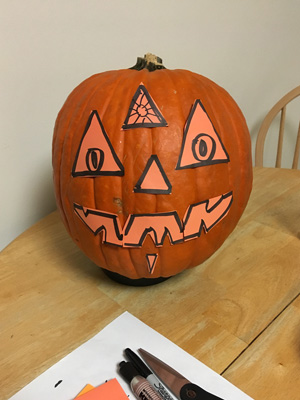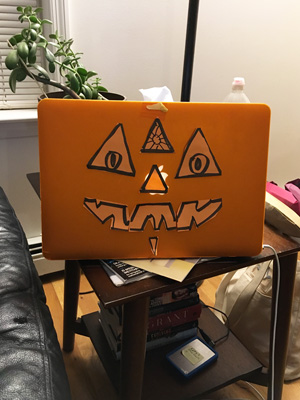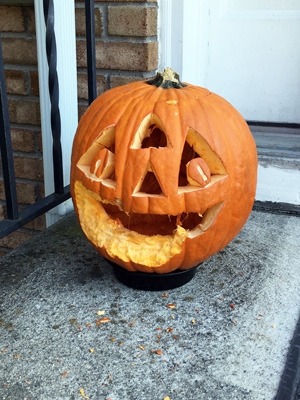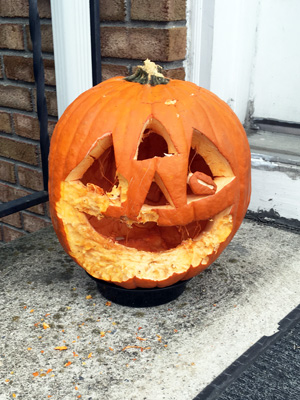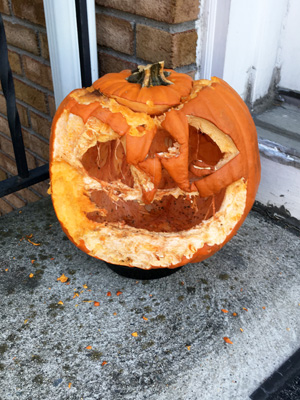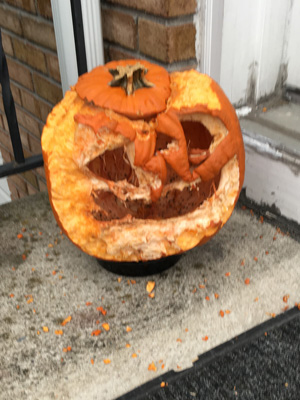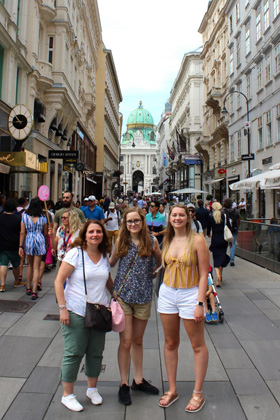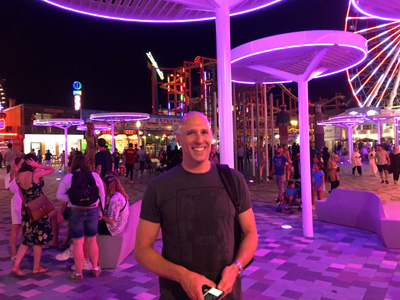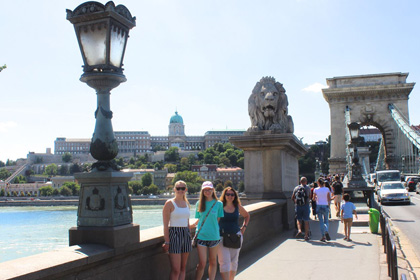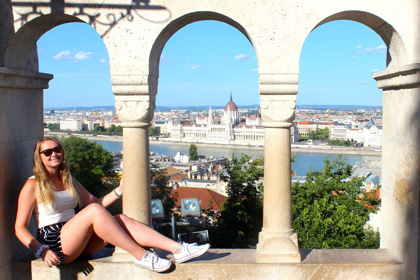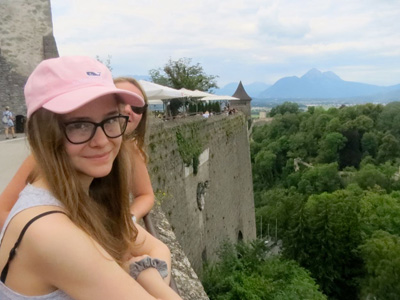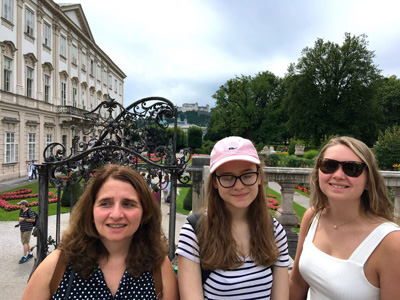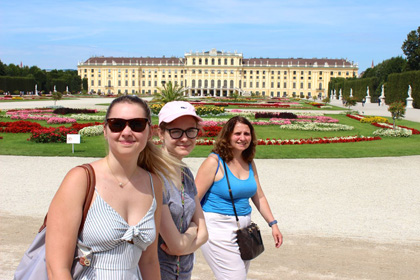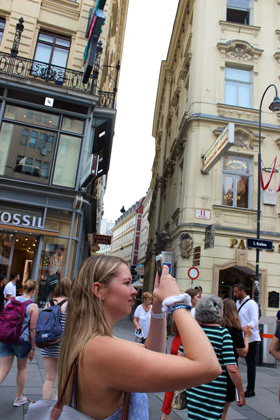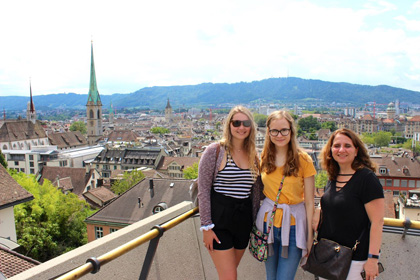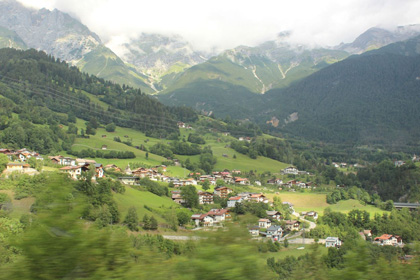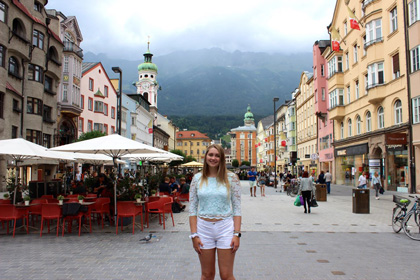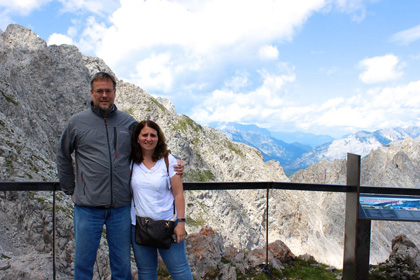Fall is proceeding apace. Hallowe’en is just around the corner, time for fun costumes, jack-o-lanterns, lawn decorations, witchcraft, devilry and all.
Things have actually been pretty boring around here recently. Work work work, getting things done. Sunday was a quiet rainy day at home, Hallowe’en devilry aside. There’s been lots of rain this October, which makes up for a dry September, but the weather has been generally pretty warm and mild. I’ve been able to get out skating and for a bike ride every week.
A couple weeks ago I was out for a bike ride in the Nature Study Woods. It was Sunday morning and there was a half marathon going on that included a trail section, with the runners coming the opposite way that I wanted to do. I ended up taking a bunch of trails that I don’t normally travel, just to find the road less taken. By the time I got to the far end of the woods I decided to take the road back rather then the trails. As I was pulling up a long hill I noticed my chain slipping of it’s sprocket into the next gear. Then without warning the chain snapped.
The bike is over twenty years old, and it was the original chain. I bought the bike in California, when Google was still a tiny little startup with their offices above Palo Alto Bicycles. (I actually talked Jeannie out of applying for a job there – worst mistake of my life.) I’ve ridden that bike over tons and roads and trails. So it was not too surprising.
I took it to a place in Pelham called Danny’s Bikes, that used to be Pelham Bicycles. The replaced the chain, which was fine, but I paid for a tune up and told them specifically that the derailleur was out of alignment and need to be adjusted, but they failed to do that. I ended up adjusting it myself, which I’d done plenty of times before, since it was easier that taking back to the shop and complaining. But still.
Last weekend Jeannie and I went on a hike in the Palisades. We’ve done a couple hikes around there, down near the George and up near the Mario. This time we picked a spot midway between the two bridges, right on the NY-Hj border. We got all the way down the cliffs to the river; it was very cool.
The same weekend we saw the famous guitar player Larry Carlton at the Iridium in NYC. We went with my origami friend Marc, who is also a guitar player and into cats like that. It was a great show, and the band consisted of Larry, his son Trevor on bass, who was most excellent, plus a sax, trombone, piano and drums. He played maybe six Steely Dan songs and the rest was his own stuff, sort of bluesy funk fusion. As luck would have it, Steely Dan was playing the same night uptown at the Beacon.
Speaking of origami, the OrigaMIT convention is coming up in just a couple weeks, so I’ve been folding and diagramming, ramping up and trying to finish and perfect some new models. Meanwhile OUSA has asked me to contribute some models to the annual Holiday Tree. The other night I folded one of my Giant Squid out a a 24″ square of some kind of cool paper I bought a while back. It’s over a foot tall. It looks great, very impressive. Just the finals sculpting to go.
In other news, my new recording Sun of the Son is almost done. (I know you’re been wondering since I haven’t talked about it in a while, but yeah I’ve keeping at it.) I’ve actually been working on it since the springtime, and even dusted of my alto sax to play the lead back at the end of the summer. Since then I recorded the synth solo and the piano solo, plus a few backing keyboard parts to pad things out. For the synth solo I had a concept in mind from the start, and was able to dial in the sound I wanted (a layering of several synth tones) and went down pretty smoothly. The piano solo turned out to be a bit more challenging. Since it’s just a piano you can’t rely on fancy patches or effects, it’s all down to the lines you play.
I had in mind a jazzy, bluesy solo something like Herbie Hancock or Chick Corea might do. But it turns out I can’t really play like those guys. Whatever I did came out sounding like a deranged mashup of Thelonious Monk and Keith Emerson. I guess that makes sense since I have studied those guys pretty deeply and have a fair amount of their pet riffs in my bag. So I decided to roll with it. Even so, I ended up stitching the solo together from multiple takes and it took a fair amount of effort to make if flow.
Now the tracking is done and next up was rendering out all the midi files (mainly the drums and keyboards) to audio for mixing. I finished that this weekend and began applying effects to the drum kit, mainly EQ’s and compressors. I have a default set of effects I use on my drum kit, but it always takes a fair amount of tweaking to make the drums sit right and really groove. Right now I’m honing in on the kick and snare. I want them to be present without being overpowering. The song has a fair amount of dynamics, and it has to sound good soft, loud, and in between. Almost there, then it’s on to the bass.
In the rock world, I’ve been keeping an eye out for new opportunities. One ad on craigslist caught my eye recently. It’s a drummer and guitarist starting up a originals project, looking for a creative keyboardist. The cited among their influences King Crimson, Tame Impala and the Delfonics. Well this seemed weird enough, and Crimso is one of my all-time favorite bands, so I got in touch. Now he’s putting together some audio demos and wants to schedule a rehearsal/audition. Meanwhile I sent him a few of my tracks, and learned how to play In the Court of the Crimson King. We’ll see how it turns out.
Also a reminder my jazz group, Haven Street is playing Saturday November 2 at the Bean Runner Cafe in Peekskill, eight o’clock downbeat. Hope to see you there.

